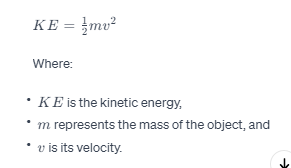NEW JERSEY, Idolmokushiroku.com – Feel free to explore further, delve into the equations, and witness the vibrant world of kinetic energy definition unfold before your eyes!
Understanding the concept of kinetic energy is pivotal in unraveling the dynamics of motion and energy transfer.
This comprehensive guide delves into the intricacies of kinetic energy, shedding light on its definition, applications, and implications across various domains.
The Essence of Kinetic Energy
Kinetic Energy Definition
Kinetic energy, in its fundamental essence, is the energy an object possesses due to its motion. This energy is a result of an object’s mass and velocity, interplaying to define the dynamic force it carries.
As an object moves, it stores and exhibits kinetic energy, making it a crucial concept in physics and engineering.
Exploring the Dynamics
Forms of Kinetic Energy
Kinetic energy manifests in diverse forms, each intricately connected to specific phenomena. These include:
Translational Kinetic Energy
Translational kinetic energy is associated with the linear motion of an object. It’s a key factor in understanding the dynamics of moving bodies.
Rotational Kinetic Energy
In cases of rotational motion, objects exhibit rotational kinetic energy. This form is vital in analyzing the movement of spinning or rotating entities.
Vibrational Kinetic Energy
Vibrational kinetic energy pertains to the oscillatory motion of particles, a phenomenon prevalent in various natural processes.
Applications Across Disciplines
Kinetic Energy in Action
The ubiquitous nature of kinetic energy finds applications across multiple disciplines:
- Physics: Fundamental in Newtonian mechanics, kinetic energy plays a central role in elucidating the principles of motion.
- Engineering: Engineers harness kinetic energy principles in designing efficient machinery and optimizing energy transfer systems.
- Sports Science: Understanding kinetic energy aids in enhancing athletic performance and optimizing sports equipment design.
Unveiling the Mathematics
Calculating Kinetic Energy
The quantitative aspect of kinetic energy is expressed through the formula:

This equation provides a mathematical framework for precisely determining the kinetic energy of a moving object.
Kinetic Energy in Everyday Life
Practical Implications
From the bustling city streets to the serene countryside, kinetic energy surrounds us. Consider the everyday scenarios where kinetic energy is at play:
- Automobile Movement: The motion of vehicles on roads exemplifies the conversion of potential energy into kinetic energy.
- Children Playing: Swinging, running, and playing involve dynamic movements, showcasing kinetic energy in action.
Is Kinetic Energy the Sole Player?
Interconnected Energies
While kinetic energy takes the spotlight, it coexists with other energy forms, creating a dynamic interplay:
- Potential Energy: The counterpart to kinetic energy, potential energy, represents stored energy that can be converted into kinetic energy.
- Thermal Energy: In some scenarios, kinetic energy transforms into thermal energy, showcasing the interconnectedness of energy forms.
FAQs
What Factors Influence Kinetic Energy?
The magnitude of kinetic energy is directly influenced by the object’s mass and velocity.
Can Kinetic Energy Be Negative?
No, kinetic energy is always a non-negative quantity, reflecting its association with motion.
How Does Kinetic Energy Relate to Work?
The work done on an object is equal to the change in its kinetic energy, as per the work-energy theorem.
Is Kinetic Energy Conserved in Collisions?
In an isolated system, kinetic energy is conserved during elastic collisions.
What Role Does Kinetic Energy Play in Renewable Energy?
Kinetic energy from wind and water movement is harnessed to generate renewable energy through turbines.
Factors Influencing Kinetic Energy
Influenced by mass and velocity.
Negativity of Kinetic Energy
Kinetic energy is always non-negative.
Kinetic Energy and Work
Work done equals the change in kinetic energy.
Conservation in Collisions
Kinetic energy is conserved in elastic collisions.
Kinetic Energy in Renewable Energy
Utilized in generating energy from wind and water movement.
 idolmokushiroku.com
idolmokushiroku.com